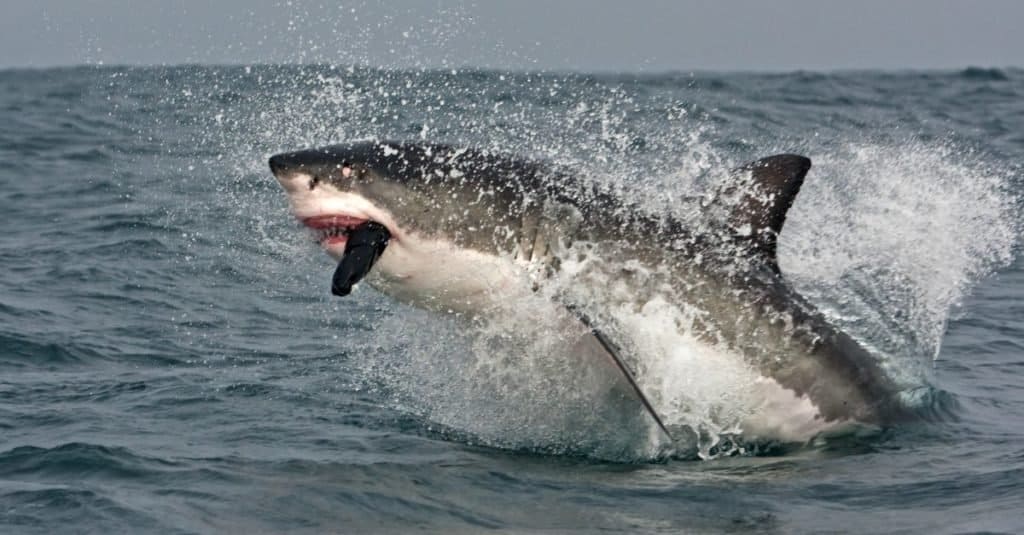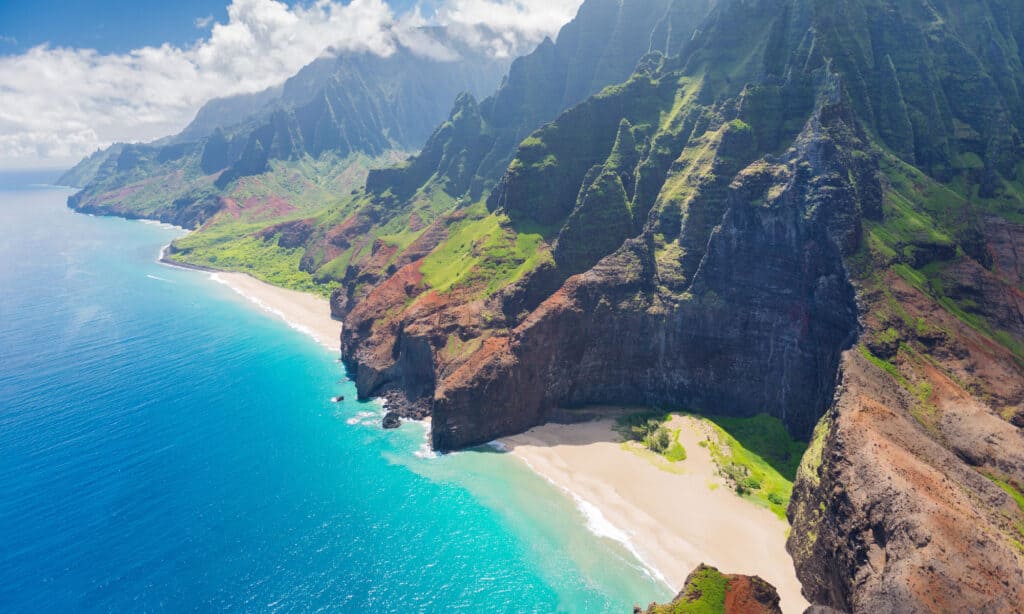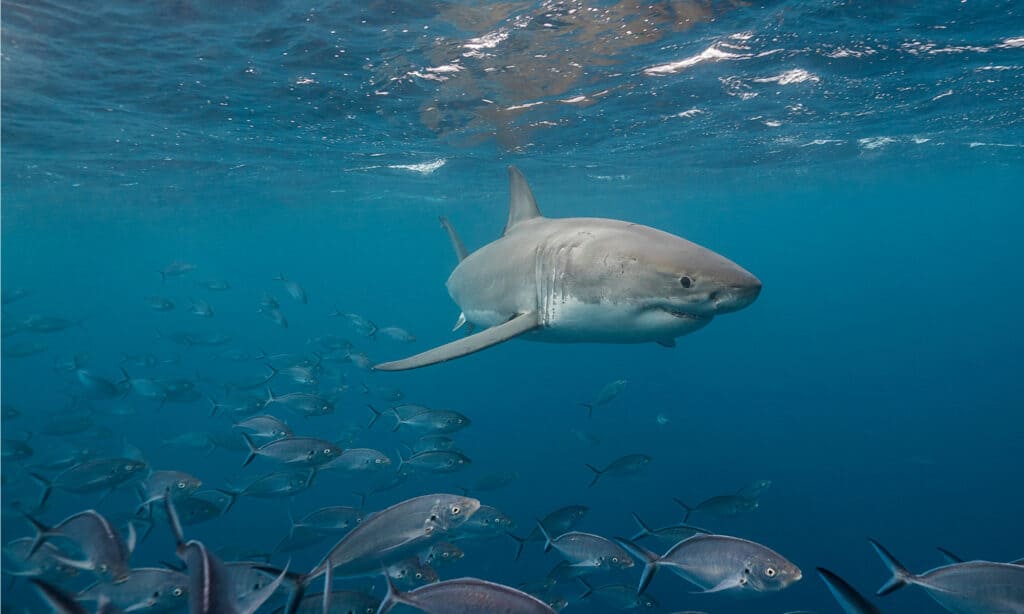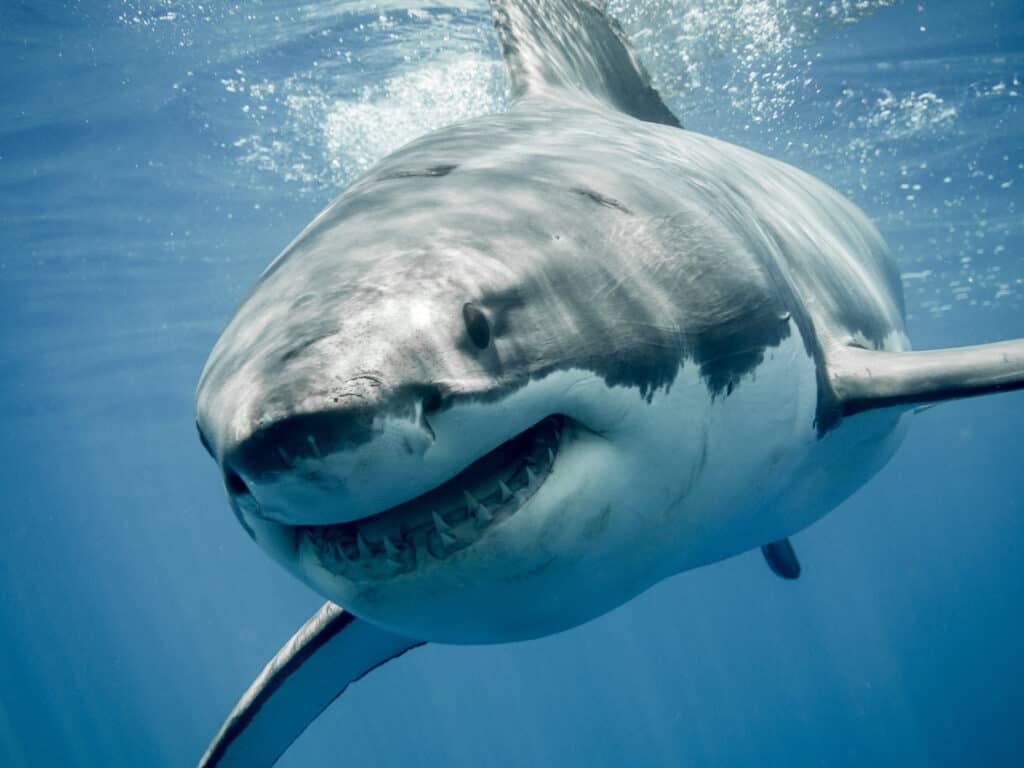More than 70% of the planet is covered by ocean waters! According to the National Geographic Society, “More than 80 percent of the ocean has never been mapped, explored, or even seen by humans.” So you can imagine that there are undiscovered animal species as well as animals that have been rarely studied. One animal we are quite familiar with, sharks, still seem to surprise us with new behaviors. Is there really a remote area of the ocean that draws Great White Sharks together? Let’s discover the odd ocean “Cafe” where Great Whites sharks gather!
What is the “White Shark Café”?

The odd ocean “Cafe” where Great White sharks gather is located between Baja California and Hawaii.
©Catmando/Shutterstock.com
The term “White Shark Café” was coined by researchers at Stanford University’s Hopkins Marine Station back in 2002 when they were studying Great White sharks in the area. By monitoring the sharks they had tagged, they were able to locate and record where they traveled over a series of years. The tags also monitored how deep the sharks dived and how long they stayed below the surface. What they found was there was an area in the ocean, halfway between Baja California, Mexico and Hawaii, where Great White sharks gathered! They nicknamed the location the “White Shark Café”.
Why would white sharks all gather in that area?
Researchers were puzzled why there was an odd ocean “Cafe” where Great white sharks gathered. Satellite images made it look like there weren’t much there, the researchers referred to it as being like a desert of the ocean. But for the sharks to survive for weeks in that location there must have been some food source.
Did researchers find the source of food for the “White Shark Café”?
Yes! In early 2018 researchers set out by boat, on the Falkor, to study the area in detail. Sure enough, they found the “Café”, an area deeper below the surface that wouldn’t be picked up on a satellite. The area was described to be rich in food and vegetation with a well-established food chain. It made sense why the sharks would migrate there and hang out for a while.
How deep can sharks dive?
If the café is deeper than the satellites can pick up, just how deep can sharks dive for food? Sharks don’t mind diving a bit to find the good stuff. The tagged sharks were recorded diving 1,500 feet (460 m) at the Café’s site (for reference a football field is 360 feet long). They would make this dive frequently with some diving as often as every 10. When they were tracked on their way out to the Café area some were recorded diving twice that distance to depths of 3,000 feet (910 m). The Navy Pier in Chicago, IL is about 3,000 feet long for reference.
What do Great White Sharks Eat?

Sharks are carnivores and will eat seals, dolphins, tuna, and even some whales.
©Martin Prochazkacz/Shutterstock.com
Great white sharks eat:
- seals
- sea lions
- harbor seals
- elephant seals
- dolphins
- beaked whales
- tuna
- mackerel
- oceanic sunfish
- some sea birds
What is the favorite food of Great White sharks?
Seals! That is what the majority of their diet consists of. When the elephant seals head to the California coast to mate, the Great Whites show up for the party because elephant seals are one of their favorite foods.
When is the odd ocean “Cafe” where Great White sharks gather the most populated?
The Great White sharks leave California/Baja California coast in the spring to migrate toward the Café area where they will summer.
How long does it take them to get to the Café?
The research indicated that it took most of the sharks around 100 days to make the trip. Their speeds were tracked at an average of 1 meter/second (3.3 feet/second) and they were recorded making dives during the journey to locate food along the way.
Where do all the sharks come from?
The tagged sharks came from rookeries all along the coast of North America.
Did all the sharks stop at the Café area, or do some go further?

Some of the sharks that were tagged decided to keep going all the way to Hawaii for summer.
©iStock.com/SergiyN
In the research study done in 2002, the researchers found that 3 out of 4 of the sharks they tagged made their way to the Café area at some point during the following 6 months after being tagged. Interestingly they also found out that some of the sharks summered in Hawaii.
Did the researchers study the sharks over a long period of time?
Yes. The research continued for years and by 2006 they found a consistent pattern of sharks traveling to the “White Shark Café” area. Some would make a pit stop of sorts spending only a little time there, while others were recorded to stay for months.
When do the Great whites head back to the California/North American shores?
In the fall the Great Whites will leave the Café and head back to the coast where there is a buffet of elephant seals. The elephant seal’s breeding season is from mid-December to the end of March.
So White Shark Café in the summer, Elephant Seal Buffet in the winter?

Elephant seals can get to be 14-16 feet long. They are one of the favorite prey of Great White sharks.
©creativex/Shutterstock.com
Yes! Elephant seals make for quite a substantial meal. While the shark prey on the younger, juvenile seals they are capable of taking down larger ones as well. Adult male elephant seals are 14-16 feet long and can weigh 2 ½ tons!
Where can you see elephant seals during the mating season in California?
One of the largest populations of elephant seals comes ashore at the Año Nuevo State Park along the San Mateo Coast south of San Francisco. The males arrive first followed by the females. You can watch the impressive mating battles between the massive whales as they vie for the attention of the females. They rear up and smash their bodies into one another with loud throaty bellows.
Where can you see Great White sharks in California?

If you want a chance at
seeing Great White sharks
in person you can take a boat tour just off Santa Cruz.
©wildestanimal/Shutterstock.com
The Santa Cruz area offers “Great White Shark Encounters” where you take a boat out with a Marine Naturalist to try to find sharks and whales. They average viewing on 70% of their tours so it might be worth the trip. Some of the Great Whites they photographed were around 10 feet. Great Whites can get to be 20 feet long and weigh 5,000 pounds! You can see why they would need a well-stocked “Café” to keep that kind of weight going.
It’s no wonder that there are Marine Naturalists taking tourists on Great White excursions in Santa Cruz – the area is part of a region known as the “Red Triangle”, an area of the California coast where a large shark population leads to an out-size number of shark attacks. The area goes from Bodega Bay to the Farallon Islands, and down Point Sur. More than one-third of all Great White Shark attacks have happened in this area of the Pacific Ocean.
Do Sharks Have a Habit of Hanging Out and Dining Together?

In spite of a reputation for being loners, sharks have surprised researchers with their ability to form social bonds
©Ramon Carretero/Shutterstock.com
According to researchers, they just might. That’s because contrary to the popular image of the lone predator prowling the depths, some sharks have actually shown surprisingly gregarious leanings.
These include the gray reef sharks which live around Palmyra Atoll and were found to form groups as large as 20 individuals and to hang out around the same spots consistently.
Scientists believe that the interest of each group in these familiar hangouts was gastronomic since there is efficiency in numbers when it comes to hunting food.
Great white sharks have shown a preference for dining with each other as proven by a 2001 study involving sharks hanging close to Año Nuevo island where the predators targeted the resident seal colony.
Another disconcerting example of these sharks’ social leanings is their habit of congregating at cage diving sites in the same company repeatedly.
The photo featured at the top of this post is © Michael Rosskothen/Shutterstock.com
Thank you for reading! Have some feedback for us? Contact the AZ Animals editorial team.







